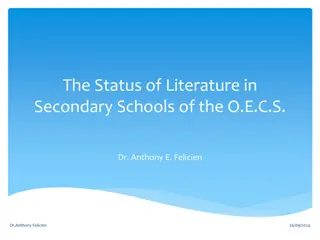Exploring Art and Literature from 1900 to the Present
Novels, plays, and poetry saw a resurgence post-Whitman and Dickinson, with writers experimenting with unique styles like interior monologue and stream of consciousness. Characters chased the American dream, expressing admiration for America as a land of opportunity. The Modernism movement reflected the radical changes of the 20th century, embracing scientific, technological, and mechanized advancements. Gertrude Stein's innovative writing mirrored modern art, using simple vocabulary and dislocated grammar to create abstract meanings. Writers of the time reflected Darwin's survival of the fittest and Karl Marx's ideas on class structure. The period also witnessed significant technological changes, the rise of youth culture, and responses to WWI and WWII, including the vibrant Harlem Renaissance.
Download Presentation

Please find below an Image/Link to download the presentation.
The content on the website is provided AS IS for your information and personal use only. It may not be sold, licensed, or shared on other websites without obtaining consent from the author. Download presentation by click this link. If you encounter any issues during the download, it is possible that the publisher has removed the file from their server.
E N D
Presentation Transcript
Art and literature from approximately 1900-the present
Novels Plays Poetry (a great resurgence after deaths of Whitman & Dickinson) Highly experimental as writers seek a unique style Use of interior monologue & stream of consciousness
Characters: in pursuit of the American dream-- Admiration for America as land of Eden Importance of the Individual: large cultural wave of Modernism, which gradually emerged in Europe and the United States in the early years of the 20th century, expressed a sense of modern life through art as a sharp break from the past, as well as from western civilization's classical traditions. Modern life seemed radically different from traditional life -- more scientific, faster, more technological, and more mechanized. Modernism embraced these changes.
Gertrude Stein (1874-1946) developed an analogue to modern art. A resident of Paris and an art collector (she and her brother Leo purchased works of the artists Paul C zanne, Paul Gauguin, Pierre Auguste Renoir, Pablo Picasso, and many others). Stein once explained that she and Picasso were doing the same thing, he in art and she in writing. Stein s work is characterized by: simple, almost childlike quality, concrete words as counters, develops abstract, experimental prose poetry. simple vocabulary recalls the bright, primary colors of modern art, while her repetitions echo the repeated shapes of abstract visual compositions. dislocating grammar and punctuation give rise to new "abstract" meanings.
Her collection Tender Buttons (1914) views objects from different angles, as in a cubist painting: A Table A Table means does it not my dear it means a whole steadiness. Is it likely that a change. A table means more than a glass even a looking glass is tall.
Writers reflect the ideas of Darwin (survival of the fittest) and Karl Marx (how money and class structure control a nation) Overwhelming technological changes of the 20th Century Rise of the youth culture Reactions and results of WWI and WWII Harlem Renaissance
Fitzgerald's The Great Gatsby Poetry of Jeffers, Williams, Cummings, Frost, Eliot, Sandburg, Pound, Robinson, Stevens Short stories and novels of Steinbeck, Hemingway, Thurber, Welty, and Faulkner Hansberry's A Raisin in the Sun & Wright's Native Son (an outgrowth of Harlem Renaissance-- see below) Miller's The Death of a Salesman (some consider Postmodern)
Mixing of fantasy with nonfiction; blurs lines of reality for reader No heroes Concern with individual in isolation Social issues as writers align with feminist & ethnic groups Usually humorless Narratives Metafiction Present tense Magic realism
Erodes distinctions between classes of people Insists that values are not permanent but only "local" or "historical" Vision and viewpoint became an essential aspect of the modernist novel as well. No longer was it sufficient to write a straightforward third-person narrative or (worse yet) use a pointlessly intrusive narrator. The way the story was told became as important as the story itself. Henry James, William Faulkner, and many other American writers experimented with fictional points of view (some are still doing so). James often restricted the information in the novel to what a single character would have known. Faulkner's novel The Sound and the Fury (1929) breaks up the narrative into four sections, each giving the viewpoint of a different character (including a mentally disabled boy).
To analyze such modernist novels and poetry, a school of "new criticism" arose in the United States, with a new critical vocabulary. New critics hunted the "epiphany" (moment in which a character suddenly sees the transcendent truth of a situation, a term derived from a holy saint's appearance to mortals); they "examined" and "clarified" a work, hoping to "shed light" upon it through their "insights."
Mailer's The Naked and the Dead and The Executioner's Song Feminist & social issue poets: Sylvia Plath, Adrienne Rich, Anne Sexton, Bill Levertov, Amiri Baraka, Toni Morrison, Alice Walker Miller's The Death of a Salesman & The Crucible (some consider Modern) Lawrence & Lee's Inherit the Wind Capote's In Cold Blood Stories & novels by Kurt Vonnegut J.D. Salinger's Catcher in the Rye Beat Poets: Kerouac, Burroughs, & Ginsberg Ken Kesey's One Flew Over the Cuckoo's Nest
Postmodern literature argues for: expansion the return of reference the celebration of fragmentation rather than the fear of it the role of reference itself in literature. While drawing on the experimental tendencies of authors such as Ernest Hemingway and William Faulkner in English, and Jorge Luis Borges in Spanish - writers who were taken as influences by American postmodern authors such as Norman Mailer, Thomas Pynchon, Kurt Vonnegut, Don DeLillo, John Barth, William Gaddis, David Foster Wallace, and Paul Auster - the advocates of postmodern literature argue that the present is fundamentally different from the modern period, and therefore requires a new literary sensibility.


![[PDF⚡READ❤ONLINE] In Ruins: A Journey Through History, Art, and Literature](/thumb/20543/pdf-read-online-in-ruins-a-journey-through-history-art-and-literature.jpg)




















